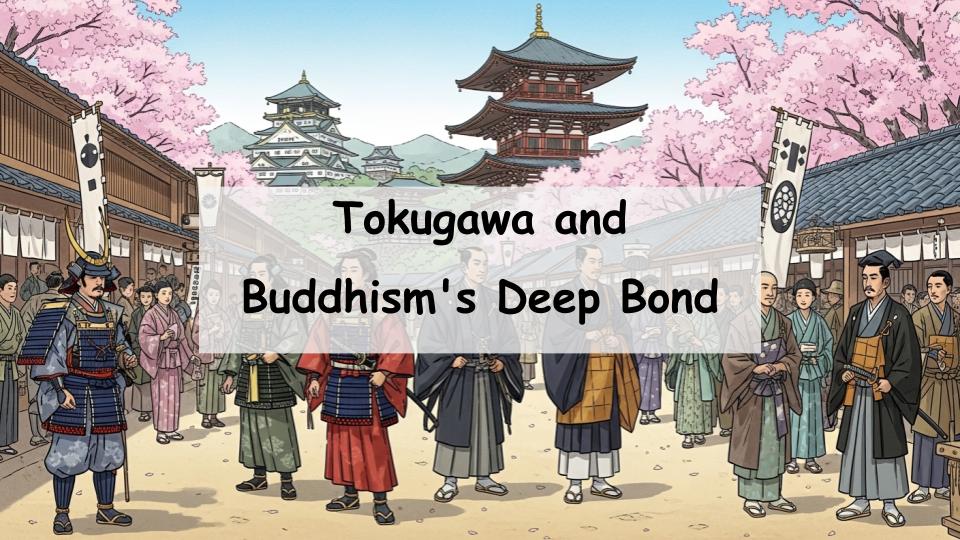“What’s the relationship between the Tokugawa family and Buddhism?”
Have you ever wondered about this? The Tokugawa shogunate, a symbol of authority during the Edo period, maintained a deep and strategic relationship with Buddhism—one that went beyond personal faith to influence the politics and structure of society itself.
In short, the Tokugawa family skillfully used Buddhism to reinforce social order and strengthen their ruling system. By publicly embracing Buddhist beliefs and forming close ties with temples, the shoguns legitimized their rule and extended their influence over the people.
This article explores how successive Tokugawa shoguns interacted with Buddhist sects, the policies they implemented to support temples, and the purposes behind these religious strategies. By understanding the Tokugawa family’s approach to Buddhism, you’ll gain a richer view of Edo-period politics and the interplay between faith and governance.
- What Was the Relationship Between the Tokugawa Family and Buddhism?
- How the Tokugawa Shoguns Were Involved with Buddhism
- Why Did the Tokugawa Family Protect Buddhism?
- Which Temples Had Particularly Close Ties with the Tokugawa Family?
- The Modern Significance of the Tokugawa-Buddhism Connection
- Conclusion: Why Understanding the Tokugawa-Buddhism Relationship Matters
What Was the Relationship Between the Tokugawa Family and Buddhism?
The Social Role of Buddhism in Japan
Buddhism had long been entrenched in Japanese society since the Heian period. In the medieval era, it played a central role in spiritual life, education, and even welfare. During the Edo period, its influence extended into politics, where it became an essential tool of governance.
The Start of Buddhist Policies Under the Tokugawa Shogunate
Tokugawa Ieyasu, who established the shogunate in 1603, strategically incorporated Buddhism into his political framework. By supporting specific sects and elevating religious institutions, he reinforced the moral and social foundation of his rule.
Religious Regulation and the Danka (Temple Registration) System
The Tokugawa regime implemented the Danka system, which required every household to affiliate with a Buddhist temple. This system helped prevent the spread of Christianity and enabled temples to function as administrative units under the state, responsible for population management and public order.
How the Tokugawa Shoguns Were Involved with Buddhism
Ieyasu and the Deification as Tōshō Daigongen
After his death, Tokugawa Ieyasu was deified as Tōshō Daigongen and enshrined at Nikkō Tōshōgū. This act not only sanctified his legacy but also symbolized the fusion of religious authority with political legitimacy, reinforcing the shogunate’s divine right to rule.
Temple Patronage Under Iemitsu and Tsunayoshi
Shoguns like Iemitsu and Tsunayoshi enacted generous policies toward temples such as Zōjō-ji and Kan’ei-ji, designating them as the family’s official mortuary temples. These temples served as spiritual anchors for the shogunate and highlighted the rulers’ commitment to Buddhist values.
Yoshimune’s Reform of Religion and Politics
Eighth shogun Tokugawa Yoshimune implemented fiscal reforms that included a reassessment of religious institutions. While reducing excessive spending, he reinforced the use of temples for administrative and ideological purposes, reaffirming their public utility.
Differences in Sects Among Shoguns and Their Motivations
The Tokugawa shoguns supported both the Jōdo (Pure Land) and Tendai sects. These choices were not merely personal but calculated: Jōdo was popular among the masses, while Tendai was associated with court culture and intellectual authority, giving the shogunate credibility across different social strata.
Why Did the Tokugawa Family Protect Buddhism?
To Legitimize Political Rule
By aligning with Buddhism, the shogunate claimed divine sanction and moral authority. Publicly respecting Buddhist doctrines enhanced the ruler’s image as a virtuous and rightful leader in the eyes of the people.
To Control the Minds and Morals of the Populace
Buddhist teachings such as karma and reincarnation were instrumental in encouraging moral behavior. The regime used these doctrines to reinforce social stability and discourage rebellion or dissent.
To Use Temples for Administrative Support
Temples served administrative functions such as population registration, birth and death records, and community oversight. In many ways, they acted as local bureaucracies that extended the reach of the shogunate.
Which Temples Had Particularly Close Ties with the Tokugawa Family?
The Roles of Zōjō-ji and Kan’ei-ji
Zōjō-ji (Jōdo sect) became the Tokugawa family’s main mortuary temple, especially after the reign of Iemitsu. Kan’ei-ji (Tendai sect), built in Ueno, connected the shogunate with the imperial court’s traditional religious network. Both were deeply symbolic and politically strategic.
Why These Temples and Sects Were Chosen
The selection of these sects and temples reflected both religious and political considerations. The Jōdo sect resonated with the common people, while Tendai appealed to scholars and nobility, allowing the shogunate to bridge multiple social layers.
The Political Significance of Jōdo and Tendai Sects
Jōdo Buddhism promoted peace of mind through faith in Amida Buddha, making it ideal for mass spiritual control. Tendai Buddhism emphasized study and ritual, aligning with the cultural refinement the shogunate wished to project.
The Modern Significance of the Tokugawa-Buddhism Connection
Preserving Religious Heritage and Historical Sites
The temples protected by the Tokugawa shoguns still stand today as testaments to their historical and cultural significance. Sites like Nikkō Tōshōgū, Zōjō-ji, and Kan’ei-ji offer insights into the integration of religion and governance.
Temples as Tourist Destinations and Historical Legacy
These temples are now major tourist attractions, offering educational experiences and spiritual exploration. Their preservation also honors the Tokugawa legacy and continues to educate the public about Japan’s religious and political history.
Lessons for the Relationship Between Religion and Government Today
The Tokugawa era demonstrates how religion can be effectively used for governance—both for moral guidance and social management. Modern policymakers and historians can draw valuable insights from this historical example.
Conclusion: Why Understanding the Tokugawa-Buddhism Relationship Matters
The Core of the Tokugawa Shogunate Revealed Through Buddhism
The Tokugawa family did not rely solely on military power; they also used religion to establish and legitimize authority. Their strategic use of Buddhism reflects a deeply calculated form of governance.
A Broader Perspective on Japanese Cultural Identity
Studying the Tokugawa family’s relationship with Buddhism provides a powerful lens for understanding not only Edo-period politics but also the foundations of modern Japanese culture and values.








Comment